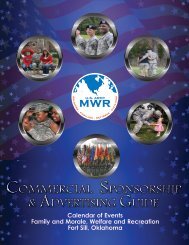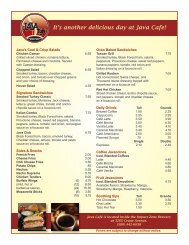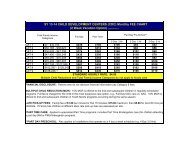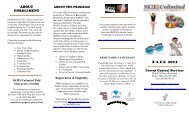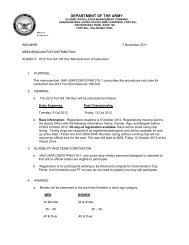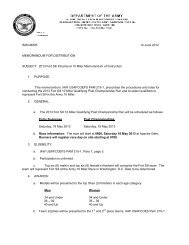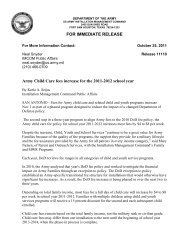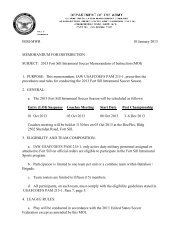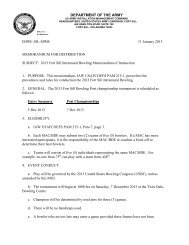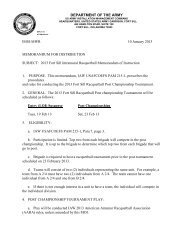Preparing and Managing Correspondence - Fort Sill MWR
Preparing and Managing Correspondence - Fort Sill MWR
Preparing and Managing Correspondence - Fort Sill MWR
Create successful ePaper yourself
Turn your PDF publications into a flip-book with our unique Google optimized e-Paper software.
Chapter 1<br />
<strong>Preparing</strong> <strong>Correspondence</strong><br />
Section I<br />
General<br />
1–1. Purpose<br />
This regulation prescribes Department of the Army (DA) policies, procedures, <strong>and</strong> st<strong>and</strong>ard formats for preparing <strong>and</strong><br />
processing Army correspondence.<br />
1–2. References<br />
Required <strong>and</strong> related publications <strong>and</strong> prescribed <strong>and</strong> referenced forms are listed in appendix A.<br />
1–3. Explanation of abbreviations <strong>and</strong> terms<br />
Abbreviations <strong>and</strong> terms used in this regulation are explained in the glossary.<br />
1–4. Responsibilities<br />
a. The Administrative Assistant to the Secretary of the Army will—<br />
(1) Establish policies <strong>and</strong> procedures for preparing correspondence on behalf of the Secretary of the Army.<br />
(2) Oversee Army correspondence on behalf of the Secretary of the Army.<br />
b. The Deputy Chief of Staff for Personnel will develop policy <strong>and</strong> direction of correspondence management for<br />
DA.<br />
c. The Deputy Chief of Staff for Operations <strong>and</strong> Plans will incorporate effective <strong>and</strong> efficient Army writing into<br />
training policy <strong>and</strong> will fund any special requirements.<br />
d. Heads of Headquarters, Department of the Army (HQDA) agencies <strong>and</strong> comm<strong>and</strong>ers of major Army comm<strong>and</strong>s<br />
(MACOMs), installations, activities, <strong>and</strong> units will supervise <strong>and</strong> manage the <strong>Correspondence</strong> Management Program<br />
within their agencies or comm<strong>and</strong>s.<br />
e. Comm<strong>and</strong>ers at all levels will actively support effective <strong>and</strong> efficient Army writing by working to eliminate poor<br />
writing in their comm<strong>and</strong>s <strong>and</strong> providing training opportunities for all Army writers.<br />
1–5. Restrictions to this regulation<br />
This regulation has been made as complete as possible to avoid the need to issue additional instructions. The<br />
correspondence formats outlined in this regulation take precedence over format instructions outlined in other regulations<br />
or directives. Therefore, supplements to this regulation will be restricted to instructions that are unique to an<br />
agency or comm<strong>and</strong>. Guidance found in DA Memo 25–52, dated 15 September 1996 (Staff Action Process <strong>and</strong><br />
<strong>Correspondence</strong> Policies), must be followed when preparing correspondence for signature by the Secretary of Defense;<br />
Secretary of the Army; Chief of Staff, Army; Vice Chief of Staff, Army; <strong>and</strong> the Director of the Army Staff.<br />
1–6. Objectives<br />
The objectives of this regulation are to—<br />
a. Create a st<strong>and</strong>ard of acceptance for written communication in the Army.<br />
b. Provide clear instructions for the preparation of all correspondence. This should reduce the time needed for<br />
training in this area.<br />
c. Reduce the cost of preparing correspondence.<br />
d. St<strong>and</strong>ardize the preparation <strong>and</strong> distribution of correspondence.<br />
Section II<br />
General <strong>Correspondence</strong> Guidance<br />
1–7. Methods of communication<br />
a. Personal or telephone contact. Whenever possible <strong>and</strong> appropriate, conduct official business by personal contact,<br />
local telephone, Defense Switched Network (DSN) or electronic mail (e-mail). A memor<strong>and</strong>um for record (MFR)<br />
should be used to document any decisions or agreements reached during these communications.<br />
b. Memor<strong>and</strong>um. The memor<strong>and</strong>um will be used for correspondence within a department or agency, as well as for<br />
routine correspondence to Federal Government agencies outside the Department of Defense (DOD). Do not use the<br />
memor<strong>and</strong>um format for corresponding with the families of military personnel or private businesses. See paragraph 2–2<br />
for the proper use of the memor<strong>and</strong>um.<br />
c. Letter. Letters will be used for correspondence addressed to the President or the Vice President of the United<br />
States, members of the White House staff, members of Congress, Justices of the Supreme Court, heads of departments<br />
<strong>and</strong> agencies, State governors, mayors, foreign government officials, <strong>and</strong> the public. Letters may also be used to<br />
AR 25–50 • 3 June 2002<br />
1




